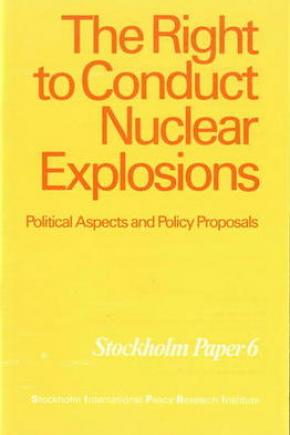The Right to Conduct Nuclear Explosions: Political Aspects and Policy Proposals
Article VIII.3 of the Treaty on the Non-Proliferation of Nuclear Weapons (NPT) states that: "Five years after the entry into force of this Treaty, a conference of Parties to the Treaty shall be held in Geneva, Switzerland in order to review the operation of this Treaty with a view to assuring that the purposes of the Preamble and the provisions of the Treaty are being realized". This Review Conference will take place in May 1975.
The economic and technical restraints on the production of nuclear weapons, once severe, have steadily decreased. A number of states have now, through peaceful nuclear programmes, accumulated the technical expertise and the fissile material necessary to produce nuclear weapons. As the Indian nuclear explosion shows, cost is no longer a restraint—at least for countries with significant peaceful nuclear programmes. As time passes the number of such states will grow. Whether or not these states will take up their nuclear-weapon option in the future will depend mainly on political considerations. For many states the main political barrier to proliferation is the NPT. The future success of the NPT will depend to a large extent on the outcome of the 1975 Review Conference, which will, therefore, be a crucial event in the field of arms control and disarmament.
For this reason, SIPRI has prepared a number of books on nuclear proliferation issues. These are Nuclear Proliferation Problems (1974), Safeguards Against Nuclear Proliferation (1975) and The Nuclear Age (1974).
This publication examines some of the political aspects of the proliferation issue. It was written by Mrs Alva Myrdal, former member of the Swedish Cabinet, chief Swedish delegate at the disarmament negotiations in Geneva and at the UN (1962-1973), and a member of the SIPRI Scientifical Council.
I. Introduction
II. The origins of proliferation
III. Five nuclear weapon powers
IV. The need for a pledge of nuclear security
V. Structural weaknesses within the NPT
VI. Improving NPT rules
VII. The arguments against discrimination
VIII. A special case for peaceful nuclear explosives
IX. Tenuous link between the treaties banning proliferation and testing
X. A long-term solution

